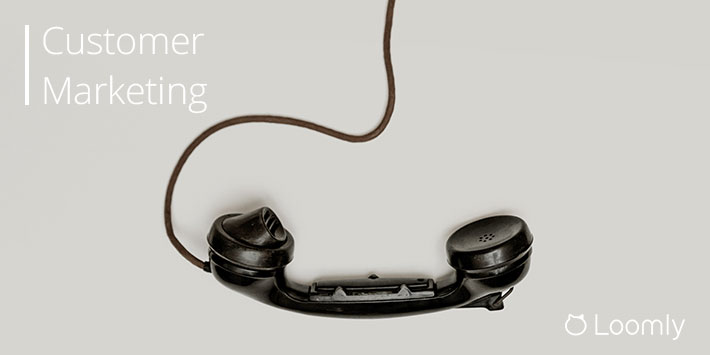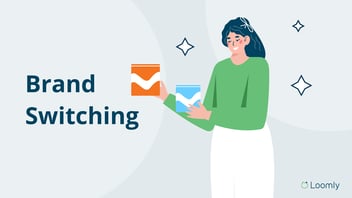For most brands, marketing to your existing customers is an untapped growth reservoir. Little do they realize that they’re sitting on a goldmine in the form of existing relationships with customers who could spend more or influence others to spend more.
According to the Gartner Group, 80% of your future profits will come from just 20% of your existing customers.
In this guide, you’ll discover what customer marketing entails and why it matters more than ever. We’ll then look at how you can design and implement a successful customer marketing campaign for your brand.
Let’s start!

Manage all your social media accounts in one place.
Craft, schedule, & auto-post content to all your social channels, then track analytics and manage interactions from a single, easy-to-use dashboard.
What is Customer Marketing
Customer marketing refers to any marketing activity or campaign that’s laser-focused on your existing customers, rather than your prospects. It can include campaigns to increase customer retention, brand advocacy, revenue growth, and community participation.
Customer marketing uses typical marketing activities but with different content, such as podcasts, blogs, videos, automated email drip sequences, whitepapers, webinars, and events.
Customer marketing is similar to customer acquisition and demand generation but has different end goals.
Demand generation and customer acquisition are focused on attracting new prospects and generating qualified leads for the sales team. Once a prospect becomes a customer, then your customer success team steps in. Their goal is to ensure new customers get the best possible values and experience from your product or service and retain them as customers.
Customer marketing goes one step further. As well as retaining them, it focuses on identifying and marketing additional products or services to existing customers and developing them into brand advocates.
Why Customer Marketing Matters More Than Ever
It costs less to market to existing customers than to acquire new customers:
- Acquiring new customers is up to 25 times more expensive than retaining existing ones.
- Increasing customer retention rates by 5% can drive profits up by 25% to 95%.
- The probability of selling to an existing customer is as high as 60-70%.
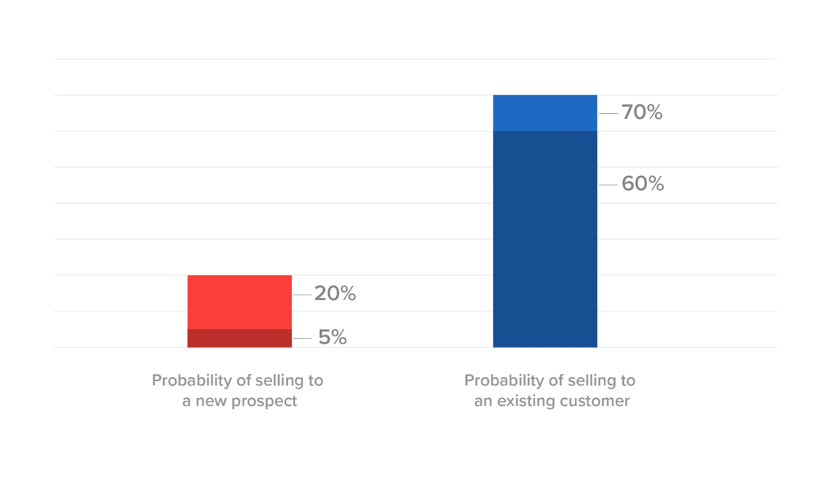
According to InMoment’s 2018 US Retail CX Trends Report, brands that achieve loyalty status with their customers get significant returns:
- 61% of loyal customers go out of their way to buy from brands they know, like, and trust.
- 60% will make more frequent purchases (rising to 70% among Millennials).
- 50% will purchase more products through upselling and cross-selling.
Plus, with all the changes the world is going through with the COVID-19 pandemic, it’s also worth considering that customer marketing creates more opportunities for upselling and cross-selling.
Also, in times of uncertainty, people tend to buy from brands they know, which gives even more value to existing brand-consumer (B2C) and vendor-buyer relationships (B2B).
In short: It’s much quicker, cheaper, and easier to cross-sell and up-sell products and services to existing loyal customers.
3 Examples of Successful Customer Marketing Campaigns
Here are three examples of successful customer marketing campaigns.
Zapier – Case studies and testimonials
Zapier does a great job of using customer stories and testimonials in their customer marketing strategy. Their Customer Stories page shows “how customers made the choice to stop working so hard, and put Zaps to work for their daily tasks.”
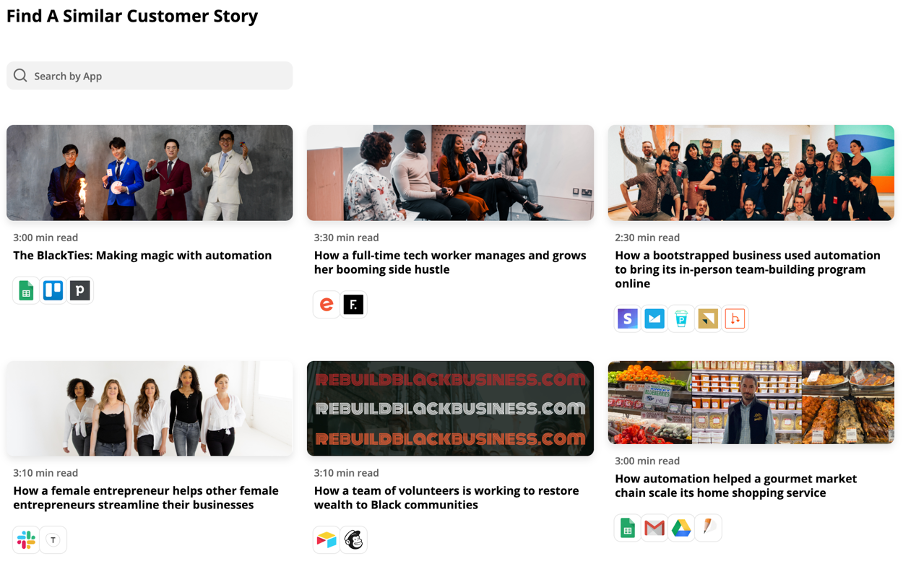
The Zapier blog also includes guides, tips, and content dedicated to common challenges facing its customers.
Starbucks Rewards – Loyalty program
Starbucks Rewards is the loyalty program from Starbucks that lets customers earn stars with every purchase through the Starbucks app. Stars can then be redeemed for free drinks or food.
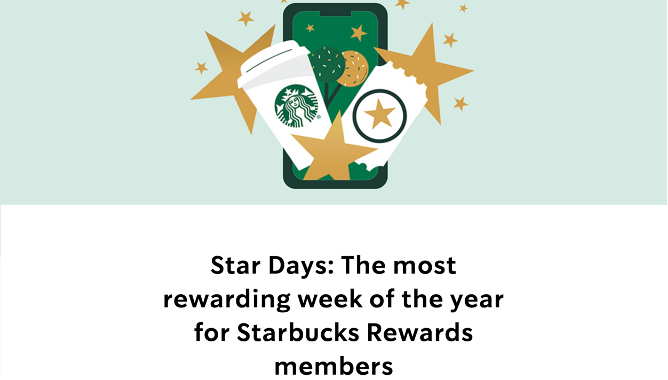
Starbucks makes the loyalty program even more rewarding with Star Days – a week of exclusive offers, games, and exciting ways to earn even more Stars towards free beverages and food – available exclusively through the Starbucks app.
Made – User-generated content
Made features user-generated content to showcase photos of their products in proud customers’ homes:
“Less than humble about your abode? Mention @madedotcom in your photos, and we’ll feature the best pics on our site.”

It’s a win-win.
Existing customers get to show-off their purchase, and potential buyers get to see how the product looks in real life, making it easier to choose.
How to Design and Implement a Successful Customer Marketing Campaign for Your Brand
Now it’s your turn.
Follow the steps outlined below to design and implement a successful international marketing campaign for your brand.
- Define your campaign goals
- Plan your campaign
- Execute your campaign
- Measure and adjust your campaign
Let’s start.
Step 1. Define your campaign goals
Start by defining your customer marketing campaign goals and metrics. You already know that the goal of customer marketing is to improve retention and increase growth.
Consider using these metrics to measure your campaign goals.
Retention metrics
- Customer retention rate (CRR) – describes the ability of a company to maintain its current customer base after acquisition.
To calculate your customer retention rate (CRR) use the customers you have at the start (S), at the end (E) and customer acquired during the period you’re measuring (N).
It looks like this: CRR = ((E-N) / S) x 100.
For example:
You have 130 customers at the start of a month. During that month you lose 9 and gain 23 new customers.
- Customer at the start S = 130
- Customers at the end E = 144
- Customers added N = 14
- CRR = ((144 – 23) / 130) x 100 = 93%
- Churn rate – refers to the percentage of people who subscribe and leave a subscription service during a specific period.
The churn rate percentage is then calculated by taking the number of customers lost in the last period and dividing it by the number of customers gained.
The calculation looks like this:
[Lost] / [Gained] x 100 = [Churn Rate %]
For example:
- Gained 1000 customers
- Lost 250 customers
- Churn rate = 250 / 1000 x 100 = 25%
- Customer lifetime value (CLV) – measures the total net worth of a customer to a company throughout their entire business relationship.
For example, if a customer buys twice from a business, spending $50 each time, and the gross profit margin rate of the company is 70%, then the customer lifetime value is ($50 + $50) x 70% = $70.
Growth metrics
- Customer acquisition costs (CAC) – refers to the amount of money needed to acquire a new customer through sales and marketing in a specific period.
For example:
- LG spent $100,000 on advertising a new Smart TV in Q1.
- They acquired 100 customers.
- Their CAC is $1,000.
- Net Promoter Score (NPS) – measures a customer’s likelihood to recommend a product or service to a friend or colleague using an NPS survey.
“How likely are you to recommend this product/service/brand to your friends, family, or colleagues?”
Customers can respond by selecting a number from one (not likely) to ten (highly likely). This then categorizes customers into one of the following:
- Detractors: Customers who select 0-6
- Passive: Customers who select 7-8
- Promoters: Customers who select 9-10
Based on the number of people in each category, brands are given a score from zero to 100. The closer to 100, the better the score.
- Average order value (AOV) – measures the average amount of money your customers spend on any one transaction with your business.
Divide revenue by the number of orders during the desired period to get the AOV.
For example:
- Revenue = $10,000
- Orders = 100
- AOV = $100
Step 2. Plan your campaign
Once you’ve defined your goals and metrics, you can start planning your campaign.
1. Analyze your existing customer data
The beauty of customer marketing is that you have a wealth of data at your fingertips. There’s no need to create a “target audience” as you already have a real one with customer demographics and buying behaviors.
Analyze your existing customer data to:
- Identify your customer advocates so that you can recruit them into your marketing activities.
- Identify the customers you’re at risk of losing, so you can figure out how to keep them on board.
- Identify trends in customer behavior, such as items commonly bought together or types of customers most likely to invest in a product upgrade.
- Identify upsell and cross-sell opportunities for related products or services.
- Create segmented lists of customers based on the types of products or services they view and buy.
2. Create personalized, relevant messaging
Based on your data, you can send personalized, relevant messages to customers based on the types of products they like, the past pages they’ve viewed, purchases they’ve made, and reviews and ratings they’ve provided.
According to the Segment State of Personalization Report, personalized and relevant messages have a greater chance of your success:
- 44% of consumers say they will likely become repeat buyers after a personalized shopping experience with a particular company
- 71% of consumers express some level of frustration when their shopping experience is impersonal.
3. Select your marketing activities
Remember, customer marketing includes a range of retention, brand loyalty, community building, and brand advocacy activities. Here are a few examples:
Reviews: Customers place more trust in online reviews than advertising, so make use of relevant platforms like Google, Facebook, and Yelp, where customers can leave reviews and ratings.
For example, you could send an email a few days after their purchase asking the customer to submit a review in exchange for 10% off their next purchase. Not only do you benefit from another positive review, but you also increase revenue through repeat business.
Testimonials: Like reviews, testimonials encourage prospects to trust your business by hearing directly from current satisfied customers. Testimonials are short snippets compared to longer case studies. Once you’ve built a strong relationship with your most passionate customers, you can request these directly either as a video or a written quote.
Cross-selling and upselling: As we already mentioned, existing customers are easier to sell to. For example, based on your customer data, you could:
- Send them an email with recommendations for products they may like based on their previous purchases.
- Offer an upgrade on their last purchase at a discounted rate.
- Offer an extra month free with their next subscription renewal.
Referral programs: People are 4x more likely to buy your product or service if a friend referred them. Referral programs use word-of-mouth marketing to encourage customers to market on your behalf.
For example, If you have a Dropbox Basic account, you’ll earn 500 MB of space for each friend you refer to Dropbox.
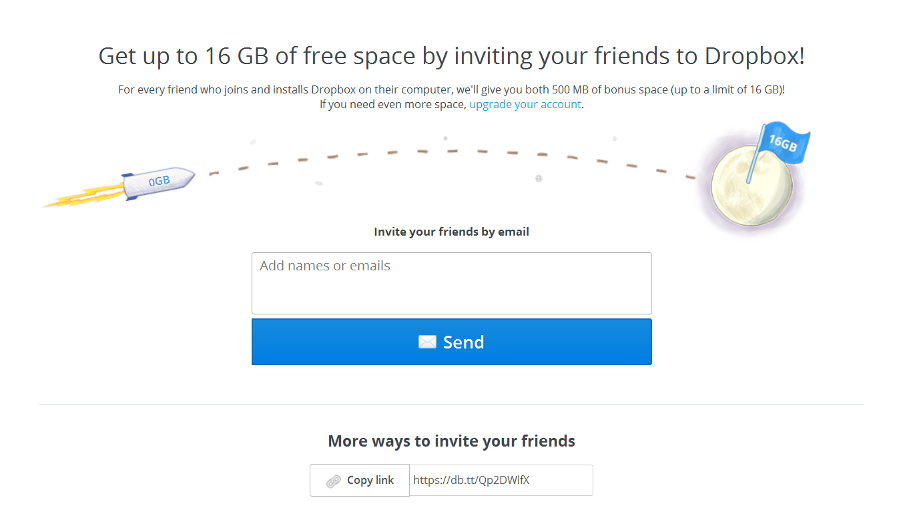
Loyalty programs: Free coffee or sandwich? That’s what you can earn with Starbucks Rewards. Loyalty programs are a great way to keep customers engaged with your brand, and they help you collect more data about the customer, which you can use to personalize future marketing efforts.
Case studies: As we saw with Zapier (above), case studies describe how your product or service helped a customer overcome their problem. These stories show potential customers exactly how you could help them.
User-generated content (UGC): Unlike testimonials, the goal of UGC is to inspire customers to share their photos, videos, messages, and blogs featuring your product or service without necessarily soliciting them.
Community building: People like to feel they’re part of a community, so if you can build one for your brand, it’s a guaranteed way of keeping your existing customers engaged with your brand, boosting customer loyalty, and generating more sales.
For instance, you could use social media platforms and forums to build an online community. Offline, you could organize events and attend trade shows.
4. Gather customer feedback
Whichever activities you choose, it’s essential to get feedback from your customers so that you can adjust your plans accordingly. Use surveys and social listening to see what they think about your campaigns.
Step 3. Execute your campaign
With everything planned, you just need to decide when and how to execute your campaign.
Here’s a quick guide on when to approach customers, broken down by strategy:
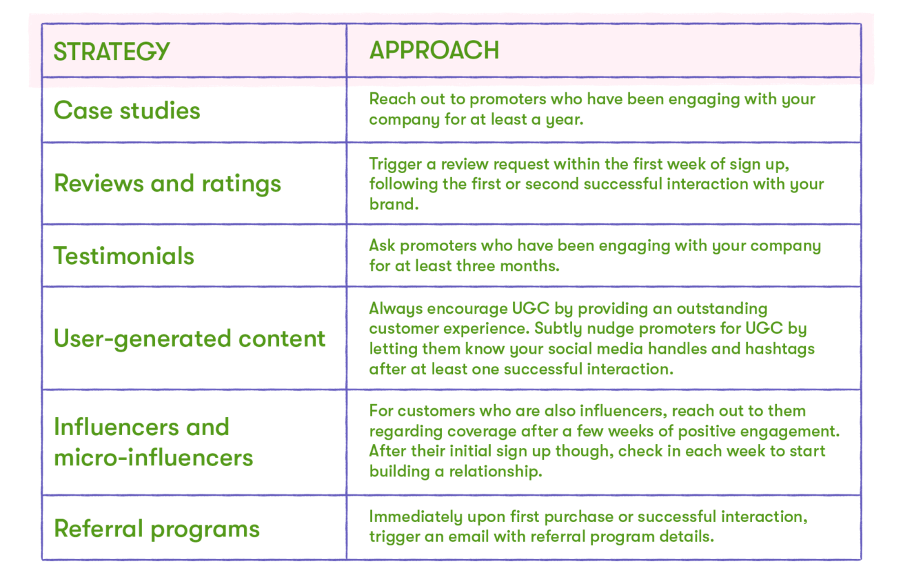
Credit: Groove
Step 4. Measure and adjust your campaign
At the end of your customer marketing campaign, you’ll need to measure your results to see if you achieved your goals. Use the retention and growth metrics from Step 1 to evaluate the performance.
Use this time to learn what went well and what didn’t so that you can make adjustments for your next campaign.
Customer Marketing in a Nutshell
Customer marketing refers to any marketing activity focused on your existing customers, and includes campaigns to increase customer retention, brand advocacy, and revenue growth.
For many brands, it’s an untapped reservoir. But when executed correctly, customer marketing can drive profits up by 25% to 95%.
If you want to design and implement a successful customer marketing campaign, you’ll need to follow these four steps:
- Define your campaign goals.
- Plan your marketing campaign.
- Execute your campaign.
- Measure and adjust your campaign.
